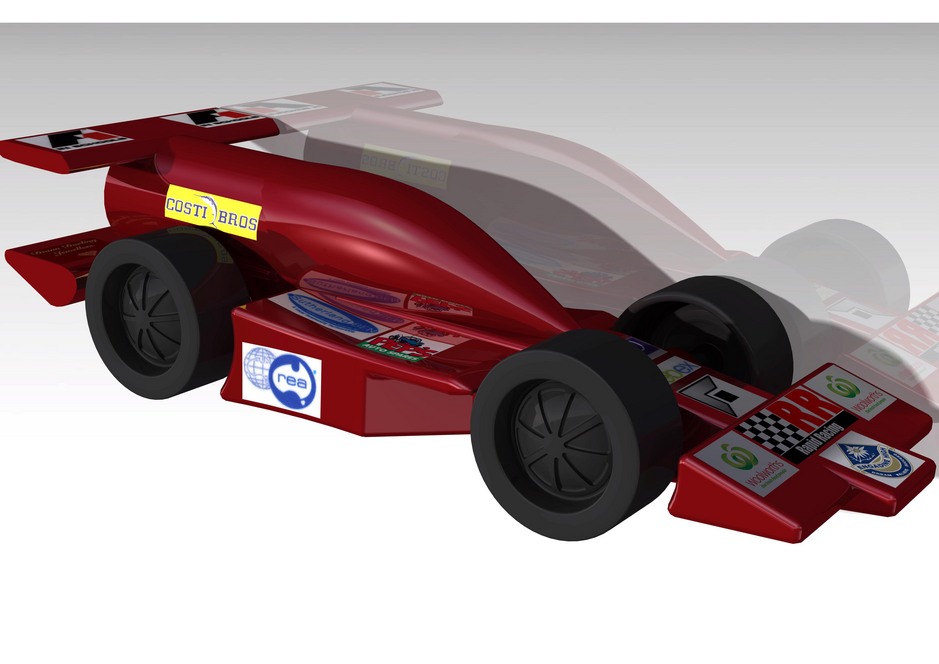
Design/Innovation
Regional Car
Front of Car:
The front wings are raised to reduce the amount of air hitting the top of the wheels.
The front wings are also tilted to protect the top of the wings even more.
The car is tilted down under the front wings to create uplift at the front of the car. It also moves the wind away from the wheels.
Hollow behind front wheels:
The hollow in the middle of the car is there to reduce weight. It is also there to create a low-pressured area and reduce the amount of drag.
It also reduces the weight at the front of the car to provide uplift and reduce friction to the front wheels.
Back of Car:
The back of the car body (under the canister hole) is tapered to reduce the amount of turbulence which also reduces drag. Some examples of this concept are found in kayaks and aero helmets.
The shape of the front of the canister is designed to make air go over the top of the wings and have less wind hit the back wheels.
The bottom of the side pods is rounded so that the air can flow under the car and create lift.
The front of the side pods go to a point so that the air can go around the outside of the car to minimize turbulence instead of getting caught in the middle.
Front of Car:
The front wings are raised to reduce the amount of air hitting the top of the wheels.
The front wings are also tilted to protect the top of the wings even more.
The car is tilted down under the front wings to create uplift at the front of the car. It also moves the wind away from the wheels.
Hollow behind front wheels:
The hollow in the middle of the car is there to reduce weight. It is also there to create a low-pressured area and reduce the amount of drag.
It also reduces the weight at the front of the car to provide uplift and reduce friction to the front wheels.
Back of Car:
The back of the car body (under the canister hole) is tapered to reduce the amount of turbulence which also reduces drag. Some examples of this concept are found in kayaks and aero helmets.
The shape of the front of the canister is designed to make air go over the top of the wings and have less wind hit the back wheels.
The bottom of the side pods is rounded so that the air can flow under the car and create lift.
The front of the side pods go to a point so that the air can go around the outside of the car to minimize turbulence instead of getting caught in the middle.
State Car
Front of the Car:
There is a wedge shape at the front of the car to split the air in half as it passes through.
The wings are positioned so that the air just makes it over the wheels without creating too much friction on the wings.
The wedge is slanted more on the bottom side than the top to create a certain amount of lift to balance the weight of the car.
The front wing follows the curve of the wheel to make it more aerodynamic.
The wings are also a wedge shape to slice through the air and protect the wheels.
Side Pods:
The side Pods are designed so the air has more momentum to go over the top and around the side of the wheel.
The bottom of the Side Pod is designed to allow the air that comes behind the wheels to flow out instead of hitting a flat surface of the side pods.
The back of the side pod follows the curve of the wheel to make it more aerodynamic, but it isn’t covering up the wheel so we can staywithin rules.
Back of the Car:
The back of the car slope is tapered up to create a high-pressured area for the air to fly out the back of the car.
The front of the canister is designed to look like a bullet and slice through the air. The even curved edge is designed to reduce the friction around the canister. Wind Tunnel testing proved this.
There is a gap between the end of the car and the start of the canister hole because it directs the air out of the CO2 canister instead of the gas spreading out everywhere.
The rear wing is to help direct the air out of the CO2 canister.
The rear skirt behind the wheels stops the air from creating a vacuum from the wheels.
The canister hole is drilled to the max depth of 60mm so that it can sit as far back in the car as possible so the rear wings can work better.
The rear skirt is designed with a slant to propel the gas being released by the CO2 canister.
Front of the Car:
There is a wedge shape at the front of the car to split the air in half as it passes through.
The wings are positioned so that the air just makes it over the wheels without creating too much friction on the wings.
The wedge is slanted more on the bottom side than the top to create a certain amount of lift to balance the weight of the car.
The front wing follows the curve of the wheel to make it more aerodynamic.
The wings are also a wedge shape to slice through the air and protect the wheels.
Side Pods:
The side Pods are designed so the air has more momentum to go over the top and around the side of the wheel.
The bottom of the Side Pod is designed to allow the air that comes behind the wheels to flow out instead of hitting a flat surface of the side pods.
The back of the side pod follows the curve of the wheel to make it more aerodynamic, but it isn’t covering up the wheel so we can staywithin rules.
Back of the Car:
The back of the car slope is tapered up to create a high-pressured area for the air to fly out the back of the car.
The front of the canister is designed to look like a bullet and slice through the air. The even curved edge is designed to reduce the friction around the canister. Wind Tunnel testing proved this.
There is a gap between the end of the car and the start of the canister hole because it directs the air out of the CO2 canister instead of the gas spreading out everywhere.
The rear wing is to help direct the air out of the CO2 canister.
The rear skirt behind the wheels stops the air from creating a vacuum from the wheels.
The canister hole is drilled to the max depth of 60mm so that it can sit as far back in the car as possible so the rear wings can work better.
The rear skirt is designed with a slant to propel the gas being released by the CO2 canister.

The Innovation of the Regional Car is the hollow in the centre.

The Innovation of the State car is the rear skirt behind the wheels
